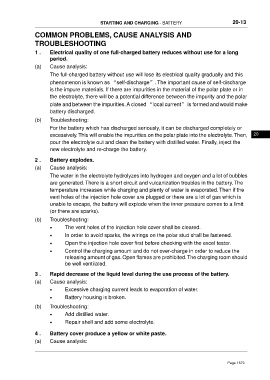Page 1579 - Foton Workshop Manual - Tunland (AT)
P. 1579
STARTING AND CHARGING - BATTERY 20-13
COMMON PROBLEMS, CAUSE ANALYSIS AND
TROUBLESHOOTING
1 . Electrical quality of one full-charged battery reduces without use for a long
period.
(a) Cause analysis:
The full-charged battery without use will lose its electrical quality gradually and this
phenomenon is known as “self-discharge”. The important cause of self-discharge
is the impure materials. If there are impurities in the material of the polar plate or in
the electrolyte, there will be a potential difference between the impurity and the polar
plate and between the impurities. A closed “local current” is formed and would make
battery discharged.
(b) Troubleshooting:
For the battery which has discharged seriously, it can be discharged completely or
excessively.This will enable the impurities on the polar plate into the electrolyte.Then, 20
pour the electrolyte out and clean the battery with distilled water. Finally, inject the
new electrolyte and re-charge the battery.
2 . Battery explodes.
(a) Cause analysis:
The water in the electrolyte hydrolyzes into hydrogen and oxygen and a lot of bubbles
are generated. There is a short circuit and vulcanization troubles in the battery. The
temperature increases while charging and plenty of water is evaporated. Then if the
vent holes of the injection hole cover are plugged or there are a lot of gas which is
unable to escape, the battery will explode when the inner pressure comes to a limit
(or there are sparks).
(b) Troubleshooting:
• The vent holes of the injection hole cover shall be cleared.
• In order to avoid sparks, the wirings on the polar stud shall be fastened.
• Open the injection hole cover first before checking with the excel tester.
• Control the charging amount and do not over-charge in order to reduce the
releasing amount of gas. Open flames are prohibited.The charging room should
be well ventilated.
3 . Rapid decrease of the liquid level during the use process of the battery.
(a) Cause analysis:
• Excessive charging current leads to evaporation of water.
• Battery housing is broken.
(b) Troubleshooting:
• Add distilled water.
• Repair shell and add some electrolyte.
4 . Battery cover produce a yellow or white paste.
(a) Cause analysis:
Page 1579

